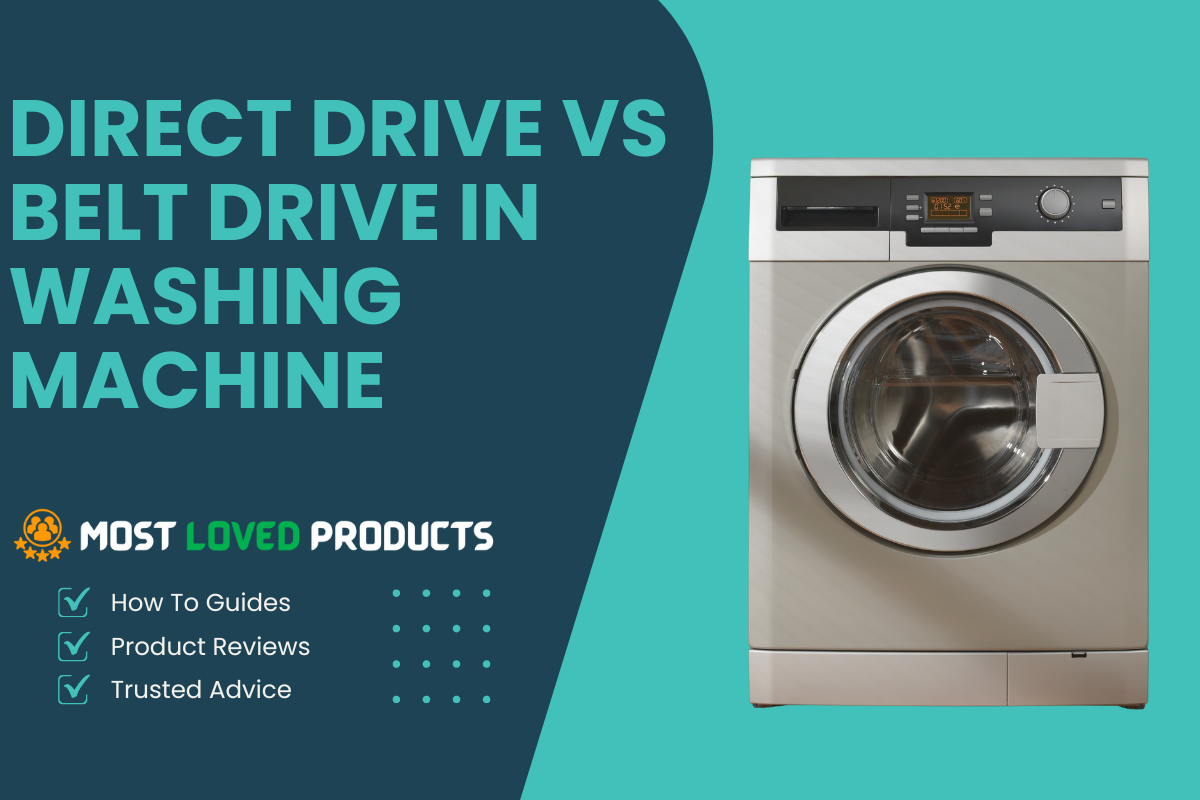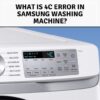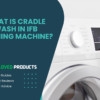One of the most common debates while analyzing washing machine technologies is – direct drive vs belt drive in washing machines.
Each system has its merits and drawbacks, depending on efficiency, durability, noise levels, and maintenance needs.
This article seeks to demystify the two mechanisms, offering a comprehensive comparison to assist consumers in making an informed decision that aligns with their household needs and preferences.
First, let’s understand how these two technologies work.
What is the Direct Drive Mechanism?
In a direct-drive washing machine, the motor is directly coupled to the drum, eliminating the need for belts or pulleys. This direct coupling allows for a more efficient power transfer, as there are fewer parts through which energy can be lost.
Benefits of Direct Drive Mechanism
- More energy-efficient as there is less power loss
- Fewer moving parts mean lower maintenance costs and less wear and tear
- Generally, it operates with less noise and vibration
Drawbacks of Direct Drive Mechanism
- Typically, more expensive upfront
- It can be heavier and more challenging to move
- Motor replacement, if necessary, could be costlier
What is the Belt Drive Mechanism?
In contrast, a belt drive washing machine employs a belt and pulley system to connect the motor to the drum. The motor powers the belt and spins the drum via the pulley system.
Benefits of Belt Drive Mechanism
- Usually more affordable initially
- Easier and cheaper to repair, particularly if the belt needs replacing
- Lighter weight, making it easier to move and install
Drawbacks of Belt Drive Mechanism
- Less energy-efficient due to more moving parts
- More susceptible to wear and tear, leading to potentially higher maintenance costs
- Typically, it is noisier and produces more vibrations

Comparison Between Belt Drive and Direct Drive Mechanism
Below is a comparison table that outlines the key differences between belt drive and direct drive mechanisms in washing machines.
| Feature | Direct Drive Mechanism | Belt Drive Mechanism |
| Initial Cost | Usually higher | Generally more affordable |
| Energy Efficiency | Higher (less power loss) | Lower (more power loss) |
| Maintenance Cost | Lower (fewer moving parts) | Higher (more moving parts) |
| Durability | Longer lifespan | May wear out faster |
| Noise Level | Generally quieter | Typically noisier |
| Vibration | Less vibration | More vibration |
| Ease of Repair | More complicated; costly parts | Easier; cheaper parts |
| Weight | Generally heavier | Lighter |
| Space Requirement | Similar in most cases | Similar in most cases |
| Special Features | More likely to have smart controls and settings | Usually basic controls |
| Environmental Impact | Generally more eco-friendly | Less eco-friendly |
Also Read: Latest Washing Machine Technologies
In-Depth Comparison of Direct Drive and Belt Drive
Below is a detail analysis of features comparing both mechanisms. Read the information thoroughly to understand which one is more suitable for your requirements.
1. Efficiency
Regarding energy and water efficiency, direct drive systems generally have an edge. By eliminating belts and pulleys, these systems reduce the number of parts that can wear out or consume extra energy.
This results in a more direct and efficient energy transfer from the motor to the drum. However, technology in belt-driven systems has improved, with some models featuring energy-saving designs.
Always check the energy rating when comparing models, as higher-rated machines can save you money over the long term, regardless of the drive system.
2. Durability and Longevity
Direct-drive washing machines usually offer more durability due to their fewer moving parts. A belt drive system can be prone to belts stretching or wearing out over time, necessitating replacement.
On the flip side, while a direct drive mechanism might be more durable when it does break down, the repair can be costly due to the complexity and expense of the parts.
When it comes to longevity, both systems can last a long time if properly maintained, although direct drive units often have a slightly longer lifespan.
3. Noise and Vibration Levels
Noise and vibration are significant considerations for those who place their washing machines close to living or sleeping areas.
Due to their streamlined design, direct drive systems tend to operate more quietly and with less vibration in washing machine. Belt drive systems often generate more noise and vibration, particularly as the belts wear out.
However, some modern belt-driven models incorporate noise-dampening technologies to mitigate this issue.
4. Cost and Affordability
Belt-drive washing machines usually come with a more attractive initial price tag. They can be less expensive to repair, especially if the belt needs replacing.
However, although more expensive up front, direct drive systems can offer cost savings in the long run through energy efficiency and lower maintenance needs. It’s essential to weigh initial and ongoing costs when deciding.
5. User Experience
Due to their modern design, direct drive systems often feature more advanced controls and customization options. They can also offer faster spin speeds, which can reduce drying time.
Belt drive systems are generally simpler, with fewer bells and whistles, making them easier to operate but with fewer features. Both types of washing machines come in various sizes and capacities, so you can find something that fits your space and needs.
6. Environmental Considerations
Environmentally conscious consumers might lean towards direct drive systems, as they consume less power and water. This lower consumption is good for the planet and reflects positively on your utility bills.
Belt drive systems, while less energy-efficient, are making strides in incorporating eco-friendly features, so it’s worth looking at the specs if environmental impact is a concern for you.
7. Case Studies or User Reviews
Real-world experiences can offer valuable insights into the performance and reliability of both types of washing machines.
Case studies and user reviews for direct drive systems often highlight their quiet operation and efficiency but might mention their high repair costs.
For belt drive systems, reviews may focus on affordability and ease of repair but could point out higher noise levels and vibrations. These first-hand accounts can provide a well-rounded view, helping you make a more informed decision.
Conclusion
Choosing between a direct drive and belt drive washing machine is a decision that hinges on factors such as energy efficiency, durability, noise levels, and cost.
Direct drive models generally offer greater energy efficiency, lower maintenance needs, and quieter operation but come at a higher initial price point. On the other hand, belt drive machines are often more affordable upfront and easier to repair but may be less energy-efficient and noisier over time.
A direct drive model could be the best fit for those prioritizing long-term savings, environmental concerns, and quieter operations. However, if initial cost and ease of repair are your primary considerations, a belt drive could be the more practical choice.
Ultimately, the “best” option will vary from person to person, depending on individual needs and priorities. Carefully weigh the pros and cons of each to make an informed decision that aligns with your household demands and lifestyle.
Some Frequently Asked Questions
Which type of washing machine is more energy-efficient?
Direct-drive washing machines are generally more energy-efficient as they have fewer moving parts, which results in less energy loss. However, some high-end belt drive models also come with energy-saving features.
Are direct-drive washing machines more expensive?
Yes, direct-drive models are typically more expensive upfront than belt-drive models. However, they often offer long-term savings through lower maintenance and energy costs.
Which type is easier to repair – belt drive or direct drive?
Belt-drive washing machines are usually easier and less expensive to repair. Replacing a belt is generally simpler and cheaper than fixing the motor in a direct drive model.
Do belt drive machines have a shorter lifespan?
While belt drive machines can be more susceptible to wear and tear due to more moving parts, their lifespan can be pretty comparable to direct drive models if well-maintained.
Which type is quieter- belt drive or direct drive?
Direct-drive washing machines are generally quieter than belt-drive machines. They have fewer moving parts, leading to less noise and vibration.
Can I switch from one type to another?
Generally, no. The type of drive is built into the design of the washing machine, so it’s not something that can be easily changed.
Are there size differences between the two?
Both types of washing machines come in various sizes and capacities. However, the length usually does not depend on the kind of drive but on the model and its features.
What should I consider for environmental impact?
If environmental impact is a significant concern, direct drive models are usually the better choice as they tend to be more energy-efficient and use less water.
Is one type better for larger loads?
Both types can handle large loads, but direct drive models may offer faster spin speeds, resulting in shorter drying times. However for longevity of the washing machine, avoid using larger loads frequently.
Where can I find user reviews or case studies?
User reviews can be found on retail websites, forums, and consumer review sites. Case studies may be published in home appliance magazines or specialized websites.





